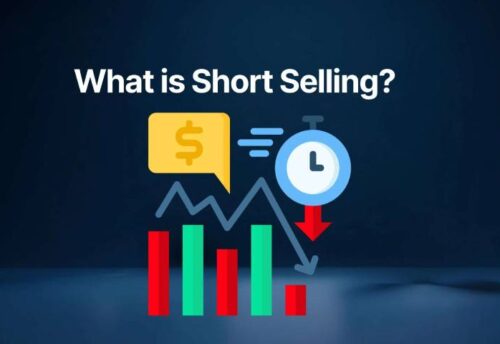
- 07/08/2025
- MyFinanceGyan
- 740 Views
- 4 Likes
- Share Market
Moving Averages in the Share Market
The stock market is full of unpredictable ups and downs. Amid all the noise, traders and investors need reliable tools to identify trends and make informed decisions. One of the most trusted tools in technical analysis is the Moving Average (MA).
Whether you’re new to the stock market or looking to sharpen your trading strategies, this guide will help you understand what a moving average is, its types, uses, and how to apply it in real trading scenarios.
What is a Moving Average?
A Moving Average smooths out price data over a selected period to give you a clearer picture of the overall trend by filtering short-term price fluctuations.
In simple terms, it shows the average price of a stock or index over a number of days, weeks, or months—helping you identify trends and possible reversal points.
Why Use Moving Averages in Trading?
- Detect trend direction(uptrend, downtrend)
- Spot buy or sell signals
- Act as support/resistance levels
- Filter out market “noise”
- Assist in building rule-based strategies
Types of Moving Averages:
1. Simple Moving Average (SMA):
- Formula: Average of the closing prices over a specific period.
- Example: 10-day SMA = average of the last 10 closing prices.
- Best for: Medium- to long-term trend analysis
2. Exponential Moving Average (EMA):
- Gives more weight to recent prices.
- More responsive to price changes than SMA.
- Best for: Short-term traders needing faster signals.
How to Use Moving Averages Effectively?
1. Identifying the Trend:
- Price above MA = Uptrend
- Price below MA = Downtrend
2. Moving Average Crossovers:
- Golden Crossover: 50-day MA crosses above 200-day MA → Strong Buy Signal
- Death Cross: 50-day MA crosses below 200-day MA → Sell Signal
3. Support and Resistance:
- In an uptrend, MA acts as a support level.
- In a downtrend, MA can act as resistance.
4. Buy/Sell Signals:
- Buy when price crosses above MA.
- Sell when price drops below MA.
- Works better with indicators like RSIor MACD for confirmation.
Real-World Example:
Let’s say you track the 50-day SMA on Reliance stock:
- If the price consistently bounces off the 50-day line and moves up, it’s a bullish sign.
- A golden crossover with rising volume confirms strength in the trend.
Advantages of Using Moving Averages:
- Easy to use and interpret
- Customizable for different timeframes
- Confirms trends and helps avoid random price noise
- Good for backtesting strategies
Limitations of Moving Averages:
- Lagging indicator: reacts after the price moves
- Can give false signals in sideways/choppy markets
- May cause delayed entries/exits
- Should be used with other indicators for accuracy
Best Practices:
- Combine two moving averages (like 20-SMA + 50-SMA)
- Check volume patterns for stronger confirmations
- Avoid relying on a single indicator—combine with RSI, MACD, etc.
- Always backtest before applying any strategy live
Beginner Strategy Using Moving Averages:
Try this simple 50-day SMA approach:
- Choose a trending stock (e.g., HDFC Bank, Infosys)
- Plot the 50-day SMA on the daily chart
- Buy when the price touches and bounces up from the line with strong volume
- Exit if the stock closes below the 50-day SMA for 2 consecutive days
This strategy works well in strong trending conditions.
For Intraday Traders:
Use shorter-term EMAs:
- 5 EMA, 9 EMA, or 20 EMA on 15-min or hourly charts
- Great for spotting quick trend changes and breakouts
- Popular strategy: EMA crossover on 15-minute chart
For Long-Term Investors:
Use:
- 100-day or 200-day SMA
- Helps ride long-term trends and avoid big losses during downturns
- Example: During market crashes, breaking below the 200-DMA often signals caution
Conclusion:
Moving Averages are a core part of technical analysis. They’re simple, versatile, and effective for identifying market trends, building strategies, and reducing market noise. However, no indicator is foolproof. Use moving averages as part of a broader trading toolkit—combine them with other indicators like RSI, MACD, or volume analysis, and always apply solid risk management. With practice and experience, you’ll gain more confidence and consistency in your trading decisions.
For more latest updates on trading strategies, technical indicators, and smart investing tips, My Finance Gyan brings you simplified financial content that helps you make better market decisions.
FAQs
The 50-day SMA—simple, reliable, and widely used.
EMA gives more weight to recent prices, reacting faster than SMA.
Yes! Try 9 EMA or 20 EMA on 15-minute charts for quick trades.
They work best in trending markets, not sideways ranges.
No. Combine with volume, RSI, MACD, and risk management for best results.



